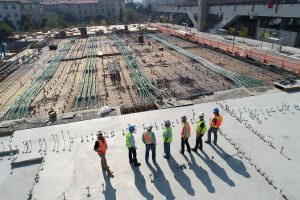Collecting overdue payments from Saudi importers of agricultural products can be a complex process that requires an understanding of the local legal framework, effective communication strategies, and a structured approach to debt recovery. Navigating the intricacies of Saudi commercial law, cultural nuances, and financial considerations are essential for foreign creditors seeking to recover debts. This article outlines a systematic approach to collecting overdue payments, emphasizing the three-phase recovery system implemented to streamline the collection process.
Key Takeaways
- Understanding Saudi Arabia’s legal framework for debt collection is critical, including commercial laws and jurisdictional issues affecting foreign creditors.
- Effective communication with Saudi debtors requires cultural sensitivity and the use of various channels, adhering to best practices for initiating contact.
- The three-phase recovery system offers a structured approach to debt recovery, from immediate actions to potential litigation and case closure recommendations.
- Financial considerations, such as collection rates, fees, and the cost-benefit analysis of legal action, play a significant role in the debt collection process.
- Creditors must make informed decisions based on the likelihood of debt recovery, options post-investigation, and the impact of aging on collection efforts.
Understanding the Legal Framework for Debt Collection in Saudi Arabia
Overview of Saudi Commercial Law
In Saudi Arabia, the commercial law landscape is a critical foundation for our debt collection efforts. We must navigate through a complex legal system to ensure compliance and effectiveness in recovering overdue payments. The Saudi legal framework is characterized by its unique blend of Sharia law and modern commercial principles, which governs all business transactions including debt recovery.
- Understanding the nuances of Saudi commercial law is essential.
- Familiarity with local regulations and procedures is non-negotiable.
- Adherence to legal requirements ensures legitimacy and enforceability of actions.
Our approach is always to align with the legal standards, ensuring that every step we take is within the bounds of Saudi law. This not only protects our clients’ interests but also maximizes the potential for successful debt recovery.
Jurisdictional Considerations for Foreign Creditors
When we’re dealing with Saudi importers, understanding the jurisdictional landscape is crucial. We must navigate through Saudi commercial laws and regulations that govern debt collection. As foreign creditors, we’re often at a disadvantage due to unfamiliarity with local legal processes. It’s essential to recognize that Saudi Arabia has its own set of rules and procedures, which can significantly differ from those in our home countries.
Jurisdiction plays a pivotal role in debt recovery. The location of the debtor dictates where legal proceedings must be initiated. Here’s a simplified breakdown:
- If the debtor is located within Saudi Arabia, local jurisdiction applies.
- For debtors with assets abroad, international jurisdiction may come into play.
- In cases of cross-border transactions, understanding bilateral agreements is key.
We must be prepared to adapt our strategies according to the jurisdiction involved. This might mean partnering with local experts or adjusting our approach to align with Saudi legal practices.
Lastly, it’s important to consider the financial implications of jurisdictional issues. Legal proceedings in a foreign jurisdiction can incur additional costs and complexities. We need to weigh these against the potential recovery of the debt to make informed decisions.
The Role of Local Attorneys in Debt Recovery
We understand the pivotal role local attorneys play in the recovery system for collecting overdue payments from Saudi importers of agricultural products. Their expertise in navigating the complexities of Saudi commercial law is invaluable. Local attorneys act as our boots on the ground, ensuring that all legal actions are taken promptly and in accordance with local jurisdictional requirements.
Our affiliated attorneys within the debtor’s jurisdiction take immediate action, drafting demand letters and making persistent contact attempts. This strategic approach is designed to yield results before escalating to litigation.
The decision to proceed with legal action is not taken lightly. We assess each case thoroughly, considering the debtor’s assets and the likelihood of recovery. If litigation is recommended and you choose to proceed, our attorneys will be ready to file a lawsuit on your behalf. The table below outlines the collection rates and fees associated with different scenarios:
| Claims Submitted | Accounts < 1 Year | Accounts > 1 Year | Accounts < $1000 | Attorney Placed Accounts |
|---|---|---|---|---|
| 1-9 | 30% | 40% | 50% | 50% |
| 10+ | 27% | 35% | 40% | 50% |
Remember, our goal is to recover what is owed to you efficiently and ethically, with a clear understanding of the financial implications.
Strategies for Effective Communication with Saudi Debtors
Initiating Contact: Best Practices
When we approach Saudi importers of agricultural products with overdue payments, we understand the importance of early and consistent communication. Our initial contact is not just about demanding payment; it’s about establishing a dialogue. We use a variety of communication methods—phone calls, emails, text messages, and faxes—to increase our chances of reaching the debtor.
Timing is everything. We make our first contact within 24 hours of account placement, setting the tone for urgency and professionalism. This rapid response demonstrates our commitment to resolving the issue swiftly.
We strive to build relationships with debtors, fostering a cooperative environment for negotiating timely payments.
Our experience shows that a structured approach yields the best results. Here’s a quick rundown of our initial contact strategy:
- Send the first of four letters via US Mail.
- Skip-trace and investigate to obtain the best financial and contact information.
- Make daily attempts to contact the debtor for the first 30 to 60 days.
By adhering to these practices, we lay the groundwork for successful debt recovery in Saudi Arabia, where communication frequency and timing are crucial.
Cultural Sensitivity in Debt Collection
In our pursuit of overdue payments, we recognize the importance of cultural sensitivity. Respect and understanding are paramount when dealing with Saudi importers. We approach each case with an appreciation for local customs and business etiquette.
Patience is a virtue in these negotiations. We take the time to build rapport and trust, which can be pivotal in facilitating payment. Our team is trained to navigate cultural nuances, ensuring that our communication is both effective and considerate.
- Acknowledge local business practices
- Honor religious and national holidays
- Use language that is polite and non-confrontational
We strive to balance firmness with respect, always mindful of the cultural context that influences our Saudi partners’ responses.
By integrating cultural awareness into our collection strategy, we aim to achieve resolutions that are satisfactory for all parties involved.
Utilizing Various Communication Channels
We understand the importance of diversifying our approach when reaching out to Saudi debtors. Emails, phone calls, and even text messages are part of our arsenal. But it’s not just about the medium; it’s about the message and its delivery.
Persistence is key, yet we must balance it with respect. We make daily attempts within the first 30 to 60 days, ensuring we’re heard without crossing cultural boundaries.
Our strategy is clear: Adapt communication to the debtor’s preferences while maintaining a consistent and professional tone.
Here’s a snapshot of our communication frequency:
- Initial contact within 24 hours of account placement
- Daily attempts for the first 30 to 60 days
- Escalation to affiliated attorneys if necessary
By tailoring our communication, we maximize the potential for a positive outcome.
Navigating the Three-Phase Recovery System
Phase One: Immediate Actions Post-Account Placement
Once we place an account, we hit the ground running. Within 24 hours, our team dispatches the first of four letters to the debtor. We don’t stop there; we dive deep with skip-tracing and investigations to secure the most accurate financial and contact details.
Our collectors are relentless, employing a mix of phone calls, emails, text messages, and faxes to reach a resolution. Here’s what you can expect:
- Daily contact attempts for the first 30 to 60 days
- A multi-channel approach to communication
- Persistent efforts to secure payment
Should these efforts not yield the desired results, we swiftly transition to Phase Two, engaging our network of affiliated attorneys within the debtor’s jurisdiction.
Our goal is clear: resolve the matter efficiently. If resolution proves elusive, we’re prepared to escalate, always keeping you informed every step of the way. Time is of the essence, and our actions are designed to maximize the potential for recovery.
Phase Two: Escalation to Affiliated Attorneys
Once we’ve exhausted initial recovery efforts, we escalate the matter to our network of affiliated attorneys. They’re primed to take immediate action, drafting demand letters and making direct calls to the debtor. Here’s what you can expect:
- Immediate drafting of a demand letter on law firm letterhead.
- Persistent attempts to contact the debtor via phone.
- A series of letters aimed at securing payment.
If these intensified efforts don’t yield results, we’re faced with a decision. We’ll provide a clear recommendation based on the debtor’s assets and the case facts. If the outlook is grim, we suggest closing the case, at no cost to you. If litigation seems viable, we’ll outline the next steps, including potential upfront legal costs.
We stand by our commitment: no recovery, no fees. If litigation doesn’t pan out, you owe us nothing.
Here’s a quick glance at the potential costs for proceeding with litigation:
| Jurisdiction | Estimated Upfront Costs |
|---|---|
| Local | $600 – $700 |
Remember, these costs are necessary for filing a lawsuit and are only advised if we see a reasonable chance of debt recovery.
Phase Three: Litigation and Case Closure Recommendations
When we reach Phase Three, we’re at a critical decision point. Our team will have conducted a thorough investigation, and based on our findings, we’ll recommend either closure of the case or proceeding with litigation. If the likelihood of recovery is low, we advise closing the case, freeing you from any further financial obligation to us or our affiliated attorneys.
Should litigation seem viable, you’ll face a choice. Opting out means no cost to you, but moving forward requires covering upfront legal fees, typically between $600-$700. These fees are necessary for filing a lawsuit to recover the full amount owed, including filing costs.
Our commitment is to provide clear guidance and support, regardless of the path you choose.
Our collection rates are competitive and vary depending on the number of claims and their age. Here’s a quick breakdown:
- For 1-9 claims, rates range from 30% to 50% of the amount collected.
- For 10 or more claims, rates decrease slightly, reflecting our volume discount.
In the unfortunate event that litigation does not result in recovery, we close the case with no further payment obligation on your part. This ensures that you are not left with additional financial burdens after an already challenging collection process.
Financial Considerations in Debt Collection
Understanding Collection Rates and Fees
We’re in the business of recovering what’s owed to you, and we understand that the cost of collection is a critical factor in your decision-making process. Our rates are competitive, designed to align with the value we recover for you. The fee structure is straightforward: the younger the account, the lower the fee. It’s that simple.
Here’s a quick breakdown of our standard rates:
- Accounts under 1 year: 30% of the amount collected
- Accounts over 1 year: 40% of the amount collected
- Accounts under $1000.00: 50% of the amount collected
- Accounts placed with an attorney: 50% of the amount collected
For bulk submissions of 10 or more claims, we offer reduced rates to maximize your returns. Remember, no recovery, no fee—if we don’t collect, you don’t pay.
When considering legal action, be mindful of the upfront costs. These typically range from $600 to $700, depending on the jurisdiction. Weigh these against the potential recovery to make an informed decision.
Our commitment is to provide you with a transparent and effective path to reclaim your funds. With our three-phase Recovery System, we’re equipped to handle the complexities of collecting overdue payments from Saudi importers of agricultural products and beyond.
Assessing the Cost-Benefit of Legal Action
When we consider legal action, we must weigh the potential recovery against the upfront costs. Deciding to litigate is not just about the overdue amount; it’s about the likelihood of successful recovery. We must ask ourselves: Is the juice worth the squeeze?
- Evaluate the debtor’s assets and the facts of the case.
- Consider the age of the account and the amount owed.
- Factor in the jurisdiction’s court costs and filing fees.
We’re faced with a choice: pursue litigation with associated costs or continue with standard collection efforts at no extra charge.
Our competitive rates are structured to align with your recovery success. For instance, accounts under a year old are charged at 30% of the amount collected, while older accounts incur a 40% fee. Litigation steps up the cost to 50%. Remember, if litigation doesn’t pan out, you owe us nothing further.
Managing Upfront Legal Costs and Potential Outcomes
When we decide to proceed with litigation, understanding and managing upfront legal costs is crucial. We must weigh the potential recovery against these initial expenses. Upfront costs typically include court fees and filing charges, which can range from $600 to $700, depending on the jurisdiction.
Litigation is a significant step, and we must be prepared for all possible outcomes. If our efforts to collect through legal action are unsuccessful, the case will be closed, and no further fees will be owed to our firm or our affiliated attorneys.
Here’s a quick breakdown of our collection rates:
- Accounts under 1 year in age: 30% of the amount collected.
- Accounts over 1 year in age: 40% of the amount collected.
- Accounts under $1000.00: 50% of the amount collected.
- Accounts placed with an attorney: 50% of the amount collected.
For larger volumes of claims, we offer reduced rates, reflecting our commitment to providing competitive collection services.
It’s essential to remember that the decision to litigate should be based on a thorough investigation of the debtor’s assets and the likelihood of recovery. This ensures that we are making informed decisions that align with our financial interests.
Making Informed Decisions on Overdue Payments
Evaluating the Likelihood of Debt Recovery
When we consider the recovery of overdue payments, we must assess each case on its own merits. The likelihood of successful debt recovery hinges on a multitude of factors, including the age of the account and the debtor’s financial status. Our three-phase Recovery System is designed to maximize this likelihood through a structured approach.
- Phase One: Immediate action is taken to contact the debtor and negotiate a resolution.
- Phase Two: If initial attempts fail, the case is escalated to our network of affiliated attorneys.
- Phase Three: We recommend either case closure or litigation based on a thorough investigation.
Our experience shows that early intervention is crucial. The longer a debt remains uncollected, the more challenging recovery becomes. We prioritize swift action to prevent the aging of accounts from eroding their recoverability.
Assessing the debtor’s assets and the facts of the case is essential. If the investigation reveals a low probability of recovery, we may advise against further action to avoid unnecessary expenses. Conversely, if the prospects are favorable, we will outline the next steps, including potential legal proceedings and associated costs.
Options Available to Creditors Post-Investigation
After we’ve delved deep into the debtor’s situation, we’re faced with a critical juncture. We can either close the case or gear up for litigation. If the odds aren’t in our favor, we’ll advise shutting it down, sparing you any further costs. But if there’s a glimmer of hope, the choice is yours.
Should you opt out of legal proceedings, you’re free to retract the claim at no charge. Alternatively, we can keep the pressure on through standard collection methods. Deciding to litigate? Be prepared to cover upfront legal expenses, which typically fall between $600 to $700.
Our commitment is clear: if litigation doesn’t pan out, you owe us nothing. It’s a no-risk proposition to ensure your peace of mind.
Here’s a snapshot of our collection rates:
-
For 1-9 claims:
- Accounts under 1 year: 30% of collected amount
- Accounts over 1 year: 40% of collected amount
- Accounts under $1000: 50% of collected amount
- Accounts with attorney involvement: 50% of collected amount
-
For 10+ claims:
- Accounts under 1 year: 27% of collected amount
- Accounts over 1 year: 35% of collected amount
- Accounts under $1000: 40% of collected amount
- Accounts with attorney involvement: 50% of collected amount
We tailor our rates competitively, ensuring you get the most out of the recovery process.
The Impact of Aging on Collection Efforts
As we delve into the intricacies of debt collection, we recognize that the age of the account significantly influences our strategy. The older the debt, the more challenging the recovery process becomes. Our experience shows that prompt action is crucial; the longer a debt remains unaddressed, the more it may slip through the cracks of recovery.
We prioritize the resolution of overdue accounts to maintain financial stability, implementing effective strategies and proactive enforcement for successful recovery.
Here’s a snapshot of our collection rates based on the age of the account:
| Age of Account | Collection Rate |
|---|---|
| Under 1 year | 30% |
| Over 1 year | 40% |
It’s evident that as debts age, the cost of collection escalates. We’re committed to addressing overdue accounts swiftly to mitigate these costs. Utilizing third-party collection partners can be a pivotal component in this endeavor, especially when compliance with Saudi Arabia’s strict import regulations is a factor.
Navigating overdue payments can be a complex and stressful process, but with Debt Collectors International, you can make informed decisions and take action to recover what’s owed to you. Our team of expert collectors is ready to provide you with specialized solutions tailored to your industry. Don’t let unpaid debts disrupt your business—visit our website today to learn more about our services and how we can assist you in managing your accounts receivable effectively. Take the first step towards securing your financial stability by reaching out to us now.
Frequently Asked Questions
What legal considerations must foreign creditors be aware of when collecting debts in Saudi Arabia?
Foreign creditors should understand Saudi Commercial Law, jurisdictional matters, and the importance of hiring local attorneys experienced in debt recovery.
How should initial contact be made with Saudi debtors to ensure effective communication?
Initial contact should be professional, respectful, and culturally sensitive, using preferred communication channels such as calls, emails, or formal letters.
What immediate actions should be taken in Phase One of the Recovery System after an account is placed?
Actions include sending letters, skip-tracing, investigating debtor’s financial status, and daily attempts to contact the debtor for resolution within the first 30 to 60 days.
What happens if the debt collection escalates to Phase Two with affiliated attorneys?
The attorney will send demand letters on law firm letterhead and attempt to contact the debtor via telephone to resolve the debt. If unsuccessful, recommendations for Phase Three are considered.
What are the potential recommendations during Phase Three of the debt collection process?
Recommendations include case closure if recovery is unlikely, or litigation if there’s a possibility of debt recovery. Legal action requires upfront costs, but no further fees if unsuccessful.
How does the age of the account and the number of claims affect the collection rates and fees?
Collection rates vary based on account age, amount, and number of claims. Rates range from 27% to 50% of the amount collected, with higher rates for older accounts and those under $1000.





